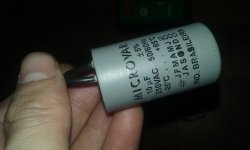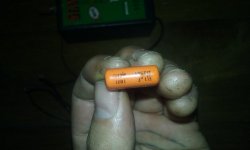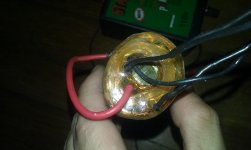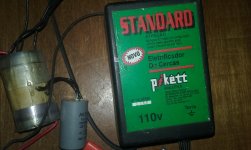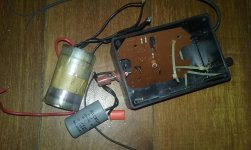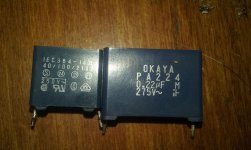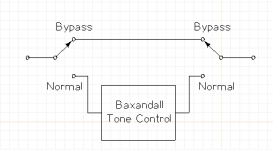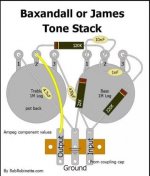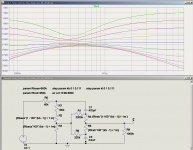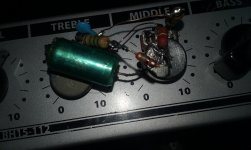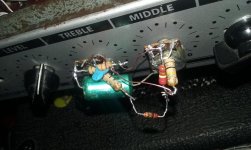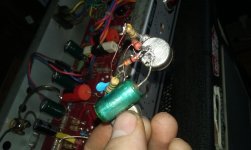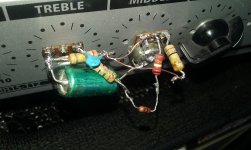From what I see in the schematics (both Spitfire and the Handsome Devil), this pot will lower gain, and simultaneously reduce bass response, as you turn down its resistance. In the Spitfire, it's labelled "Master", so it is being used as a gain control rather than a presence control.
Again, from what I see in the schematics, they are both exactly the same thing - the circuits are identical. So you definitely do not need two of them (and they would interfere with each others functioning if you did have two of them, so do not wire two of them up!)
Those are some amazing colours! I've never seen a sunset quite like that.
-Gnobuddy
thanks friend...
so i'll just use this presence as master volume without the cap and bypass the vr-2 (former master volume, pre PI)
next thing: since i'll redesign the tone stack to baxandall pattern, is there a way to use the middle knob wired as 'ground lift/raw tone/tonestack bypass' by putting in series with some ground resistor or its impossible with james/baxandall without a push-pull potentiometer or instant switch?
i've salvaged some stuff from an 'fence electrifier box' and got a phillips mkt 1uf + some sort of weird transformer + 10uf polypropylene cap (images below)
theres no info if this polypropylene is motor run or motor start, not even online... is there a way to find out?
ps: my multimeter is only reading diodes/beep... one of our dogs have dropped it and i couldnt fix
ps2: i've found some 'okaya noise filtering capacitors' inside a junk PC power supply (pics on attachment)
are they worth installing in the amp?
thanks
Attachments
Last edited:
Generic rules, tube amps like PP are very weak power of around 50 watts at 10% distortion.
50 to 100uf is enough for main power (B+). for the input and driver tubes, if they have capacitors, a good 25 uf is enough, and it pays to use a film capacitor, which is pricey if the voltages are high, worth the sound improvements.
50 to 100uf is enough for main power (B+). for the input and driver tubes, if they have capacitors, a good 25 uf is enough, and it pays to use a film capacitor, which is pricey if the voltages are high, worth the sound improvements.
Do you mean the two 0.022 uF coupling capacitors from the phase inverter anodes? Unfortunately, you cannot get rid of them: those PI anodes are at maybe +200 volts, while the control grids of the output valves are at 0 volts. Those capacitors have to be in place, to block the DC voltage. If you remove them, the output valves will overload and burn out.I'll just use this presence as master volume without the cap
I don't think you can do it with a single resistor and single-pole, single-throw switch, the way you can with a Fender tone-stack....is there a way to use the middle knob wired as 'ground lift/raw tone/tonestack bypass'
But you can use a double pole double throw toggle switch, and wire it to completely bypass the tone control in one position. If you look at "true bypass" wiring for a guitar FX pedal, you can see how it's done. I'm also attaching a schematic I drew.
(In guitar FX pedals, they often use a triple-pole, double throw switch. The third pole is used to light up an LED when the pedal is not in bypass mode. If you use a manually operated toggle switch, you don't need the LED or the third pole.)
-Gnobuddy
Attachments
Do you mean the two 0.022 uF coupling capacitors from the phase inverter anodes? Unfortunately, you cannot get rid of them: those PI anodes are at maybe +200 volts, while the control grids of the output valves are at 0 volts. Those capacitors have to be in place, to block the DC voltage. If you remove them, the output valves will overload and burn out.
I don't think you can do it with a single resistor and single-pole, single-throw switch, the way you can with a Fender tone-stack.
But you can use a double pole double throw toggle switch, and wire it to completely bypass the tone control in one position. If you look at "true bypass" wiring for a guitar FX pedal, you can see how it's done. I'm also attaching a schematic I drew.
(In guitar FX pedals, they often use a triple-pole, double throw switch. The third pole is used to light up an LED when the pedal is not in bypass mode. If you use a manually operated toggle switch, you don't need the LED or the third pole.)
-Gnobuddy
i mean the 4.7nf cap;
yeah i thought only with toggle bypass, but better ask a pro hahah
much thanks, for now i think its settled the project;
bad news...
i've removed/bypassed the master volume before phase inverter;
then removed the 4n7 presence cap and jumpered it, to make the presence pot become a master volume;
bypassed the tone stack from v1 pin 6 to v2 pin 2 with the ampeg baxandall tone stack;
no good... the amp is not working properly... the pre gain potentiometer doesn't work, the tone stack is not working as it should be... theres lots of 'farting / block distortion' and the sound only leaves the speaker when i hit real hard... after that, the amp sags very hard for about 5 seconds
really frustrating... i've done baxandall before with sucess in a tube pedal
when theres no p10 cable plugged in, the amp squeals
the classic vox-fender-marshall bass/middle/treble doesn't suit me...
i've tried to put a 22nf coupling cap from pin 6 to tonestack in and no success either
the baxandall diagram is attached below
i'm too tired, maybe life on earth isn't for me
i've removed/bypassed the master volume before phase inverter;
then removed the 4n7 presence cap and jumpered it, to make the presence pot become a master volume;
bypassed the tone stack from v1 pin 6 to v2 pin 2 with the ampeg baxandall tone stack;
no good... the amp is not working properly... the pre gain potentiometer doesn't work, the tone stack is not working as it should be... theres lots of 'farting / block distortion' and the sound only leaves the speaker when i hit real hard... after that, the amp sags very hard for about 5 seconds
really frustrating... i've done baxandall before with sucess in a tube pedal
when theres no p10 cable plugged in, the amp squeals
the classic vox-fender-marshall bass/middle/treble doesn't suit me...
i've tried to put a 22nf coupling cap from pin 6 to tonestack in and no success either
the baxandall diagram is attached below
i'm too tired, maybe life on earth isn't for me
Attachments
Last edited:
Believe me, I know what that feels like. But from what you wrote, there are things on earth that make you happier and feel better - like music and sunsets, for example.I'm too tired, maybe life on earth isn't for me
And then there are things that make you less happy and maybe quite frustrated, such as tinkering with an amplifier that already sounds good, and ending up with it sounding worse than before.
Why not decide to spend more time with the things that make you happiest? Singing, song-writing, sunsets, your loved ones? Things that recharge your internal quality-of-life bank account?
I myself have a love-hate relationship with electronics. I enjoy learning, I enjoy taking a handful of parts and putting them together so that lovely sounds come out. But I also notice that this process sucks up hours of my life, hours that I'll never get back. Bending over a hot soldering iron is a lonely job, and while I'm doing that, I'm missing out on all the best things on earth - sunlight, companionship, nature, making music.
So tinkering with electronics for too long slowly reduces the quality of my life. But simply sitting around enjoying the sunsets for too many months slowly reduces the quality of my brain.
From what I hear, you, my friend, could use some sunset-and-music time, until you have enough happiness and contentment stored up to start tinkering with electronics again!
VR-1 doesn't work? Then there is a wiring mistake. Most likely, either the ground end of the pot is not grounded, or the wiper is accidentally shorted to the "hot" end. Either of those mistakes will let almost the entire signal through, as though the pre gain was stuck at maximum.the pre gain potentiometer doesn't work
I don't like the Fender / Vox / Marshall "tone stack" either. I like the active Baxandall used in Hi-Fi amps, but when I simulated the passive versions of the Baxandall and James tone controls using LTSpice, I was disappointed to find out they produced very poor EQ curves compared to the active type.the tone stack is not working as it should be...
After a lot of hunting around, I found an old tone control circuit called the Voight tone control circuit in a book, and then I simulated it in LTSpice and tinkered with it until the curves looked right for guitar. Then I built it into a guitar preamp that I was working on at the time.
I liked the result quite a bit. The EQ curves are not too different from a (good) Baxandall, and there is very little interaction between the bass and treble knobs, also like a good Baxandall.
I have two versions of my modified Voight circuit, one for the clean channel, one for the overdrive channel. A few capacitor and resistor values are changed, the overdrive version has all the frequencies moved up a little compared to the clean version (since there are more high frequencies in an overdriven guitar signal.)
In case you're interested, I'm attaching a schematic and the simulated frequency response curves of the "clean" version here. R6 is not part of the tone control, it represents the 40k output resistance of the previous valve stage, so you can leave it off. The bass pot is 500k log (audio), the treble pot is 250k log. I tried, but could not make the circuit behave properly with any other value pots.
You may be dealing with more than blocking distortion - from your symptoms, I suspect you may be encountering instability and oscillations at high frequency (above the audio range.)theres lots of 'farting / block distortion' and the sound only leaves the speaker when i hit real hard... after that, the amp sags very hard for about 5 seconds
For a little while, just avoid the parts of life that are toxic for you. Spend time doing the things that bring you back to life.i'm too tired
Remember the discussion about the search for the Holy Grail? It is very exhausting, sucks up your life, and gives you nothing at the end. There is no magic Holy Grail guitar amp either - the magic is in the guitarist, not the guitar, or the guitar amp.
If you are low on magic, perhaps it would be best to spend time putting more magic into the guitarist?
-Gnobuddy
Believe me, I know what that feels like. But from what you wrote, there are things on earth that make you happier and feel better - like music and sunsets, for example.
And then there are things that make you less happy and maybe quite frustrated, such as tinkering with an amplifier that already sounds good, and ending up with it sounding worse than before.
Why not decide to spend more time with the things that make you happiest? Singing, song-writing, sunsets, your loved ones? Things that recharge your internal quality-of-life bank account?
I myself have a love-hate relationship with electronics. I enjoy learning, I enjoy taking a handful of parts and putting them together so that lovely sounds come out. But I also notice that this process sucks up hours of my life, hours that I'll never get back. Bending over a hot soldering iron is a lonely job, and while I'm doing that, I'm missing out on all the best things on earth - sunlight, companionship, nature, making music.
So tinkering with electronics for too long slowly reduces the quality of my life. But simply sitting around enjoying the sunsets for too many months slowly reduces the quality of my brain.So I try to find a balance between them.
From what I hear, you, my friend, could use some sunset-and-music time, until you have enough happiness and contentment stored up to start tinkering with electronics again!
VR-1 doesn't work? Then there is a wiring mistake. Most likely, either the ground end of the pot is not grounded, or the wiper is accidentally shorted to the "hot" end. Either of those mistakes will let almost the entire signal through, as though the pre gain was stuck at maximum.
I don't like the Fender / Vox / Marshall "tone stack" either. I like the active Baxandall used in Hi-Fi amps, but when I simulated the passive versions of the Baxandall and James tone controls using LTSpice, I was disappointed to find out they produced very poor EQ curves compared to the active type.
After a lot of hunting around, I found an old tone control circuit called the Voight tone control circuit in a book, and then I simulated it in LTSpice and tinkered with it until the curves looked right for guitar. Then I built it into a guitar preamp that I was working on at the time.
I liked the result quite a bit. The EQ curves are not too different from a (good) Baxandall, and there is very little interaction between the bass and treble knobs, also like a good Baxandall.
I have two versions of my modified Voight circuit, one for the clean channel, one for the overdrive channel. A few capacitor and resistor values are changed, the overdrive version has all the frequencies moved up a little compared to the clean version (since there are more high frequencies in an overdriven guitar signal.)
In case you're interested, I'm attaching a schematic and the simulated frequency response curves of the "clean" version here. R6 is not part of the tone control, it represents the 40k output resistance of the previous valve stage, so you can leave it off. The bass pot is 500k log (audio), the treble pot is 250k log. I tried, but could not make the circuit behave properly with any other value pots.
You may be dealing with more than blocking distortion - from your symptoms, I suspect you may be encountering instability and oscillations at high frequency (above the audio range.)
For a little while, just avoid the parts of life that are toxic for you. Spend time doing the things that bring you back to life.
Remember the discussion about the search for the Holy Grail? It is very exhausting, sucks up your life, and gives you nothing at the end. There is no magic Holy Grail guitar amp either - the magic is in the guitarist, not the guitar, or the guitar amp.
If you are low on magic, perhaps it would be best to spend time putting more magic into the guitarist?
-Gnobuddy
sure, lets try this voight...
and the reasons you described (interactive bass and treble with awful eq curves) are the reason i dislike the tmb stack... when i was mixing our songs on the app, i could see that even with mids full and bass/treble rolled down, there was still a hole in the middle of the wave... like a volcano
this app allowed me to free model the waveform and i could realize how important is the waveform in the overall sound
i've checked the wiring before assembling the device, but it might be that anyway
but lets see this new tonestack... i rather place it after v1 and before the PI
thanks
good news: i've fixed a minor mistake in the pre gain vr1 potentiometer wiring (was drunk last night)
now the tone stack works, the farting / blocking distortion is gone
but it still squeals like an alarm/siren when theres no instrument plugged in, the gain and volume doesnt work
maybe i've bypassed more than the tone stack with the baxandall, since i've connected the tone stack input from pin 6 v1 and the output into pin 2 v2
dunno which components should i put back in lol
thx
now the tone stack works, the farting / blocking distortion is gone
but it still squeals like an alarm/siren when theres no instrument plugged in, the gain and volume doesnt work
maybe i've bypassed more than the tone stack with the baxandall, since i've connected the tone stack input from pin 6 v1 and the output into pin 2 v2
dunno which components should i put back in lol
thx
Sorry, forgot to attach it last time.sure, lets try this voight...
I don't know if you will like it or not, but it is a simple circuit, and won't take long to build (or to take apart if you don't like it!)
No hole in the Voight response, though you get some of that mid-scoop tonal flavour if you turn bass and treble both to maximum.there was still a hole in the middle of the wave... like a volcano
Some people want the big hole-in-the-middle, because it is a big part of those classic Fender blackface clean tones.
Some years ago I bought a Danelectro Fish-n-Chips graphic equalizer pedal. Over time, it became one of my favourite FX pedals. I put it between the guitar and my guitar amp, and it let's me fine-tune the sound in a way that is much more subtle than any of the guitar amp "tone stacks" I have ever used. You can dial in a Fender notch, if you want that; or a Marshall notch, if you want that instead. Or no notch, or a midrange boost, or just about any reasonable EQ shape you can think of.
As guitar FX pedals go, this one is not expensive: Access Denied
This pedal comes in a goofy green plastic case, which I think is supposed to look a bit like a fish. The footswitch is horrible, it feels like stepping on a piece of cooked pasta. I rarely use it, I just leave the pedal on all the time. The input and output jacks are awkwardly placed at the top of the pedal, and they are very close together, so some patch-cords will not fit without the two 1/4" plugs hitting each other.
So it is not a flawless pedal, but all the important things work very well in the Fish-n-Chips: the EQ sliders are very effective, there is no problem with noise or hum or "tone suck", and there is even an optional adjustable clean boost (gain) slider if you want it.
-Gnobuddy
Attachments
Just to clarify: R2+R3 is the 500k log bass pot.
R4+R5 is the 250k treble pot.
R6 represents the previous stage (12AX7) output resistance - leave it out, it isn't part of the tone control.
R9 represents the 1M grid bias resistor of the next valve stage (12AX7). It is also not part of the tone control, so leave it out.
The actual Voight tone control circuit only has two pots, two capacitors, and three fixed resistors in it.
-Gnobuddy
R4+R5 is the 250k treble pot.
R6 represents the previous stage (12AX7) output resistance - leave it out, it isn't part of the tone control.
R9 represents the 1M grid bias resistor of the next valve stage (12AX7). It is also not part of the tone control, so leave it out.
The actual Voight tone control circuit only has two pots, two capacitors, and three fixed resistors in it.
-Gnobuddy
Excellent, progress!good news: i've fixed a minor mistake in the pre gain vr1 potentiometer wiring
Ah, I missed that earlier. Yes, that is a mistake. The new tone stack should go between pin 6 of V1 (V1B anode), and the "hot" end of the volume potentiometer VR-2.I've connected the tone stack input from pin 6 v1 and the output into pin 2 v2
Going straight into pin 2 of V2 bypasses the volume control, gives you too much gain, and most likely, that's causing the squealing when your guitar is unplugged. Fixing this (as described in the previous paragraph) will most likely fix your squealing / oscillation problem also.
R10 (220k) is not doing anything good for your Baxandall tone control, and I suggest disconnecting it. (Probably it was put there to work with the Fender tone control circuit, which you have removed.)
-Gnobuddy
Excellent, progress!
Ah, I missed that earlier. Yes, that is a mistake. The new tone stack should go between pin 6 of V1 (V1B anode), and the "hot" end of the volume potentiometer VR-2.
Going straight into pin 2 of V2 bypasses the volume control, gives you too much gain, and most likely, that's causing the squealing when your guitar is unplugged. Fixing this (as described in the previous paragraph) will most likely fix your squealing / oscillation problem also.
R10 (220k) is not doing anything good for your Baxandall tone control, and I suggest disconnecting it. (Probably it was put there to work with the Fender tone control circuit, which you have removed.)
-Gnobuddy
i've made the TS as you can see in the attachments below, the sound is really more pleasant, but i still face the problems mentioned earlier, i havent yet tried to wire the output somewhere else than v2 pin 2 as you just said
thus, theres no more vr-2 volume pot.
i've disconnected the pot from the circuitry
the master volume is vr-6 with the 4,7nf presence capacitor removed/bypassed (post phase inverter master volume)
i think its useful to state that i've also disconnected the following:
vr-3, vr-4, vr-5 pots
r8, r9, r10 resistors
c5, c6, c7, c8, c13 capacitors
ps: this new tone stack is also more pleasant to build than baxandall... sorry it seems messy on p2p... i had no clue how to install it straight into the pcb
thanks!
Attachments
Last edited:
Since this current arrangement isn't working, why not disconnect one end of Vr-6, and put Vr-2 back?thus, theres no more vr-2 volume pot.
<snip>
the master volume is vr-6 with the 4,7nf presence capacitor removed/bypassed (post phase inverter master volume)
Too many changes to keep track of...time to redraw & update the circuit, showing it as it is now. That will make it a lot easier to understand what is going on.i think its useful to state that i've also disconnected the following:
vr-3, vr-4, vr-5 pots
r8, r9, r10 resistors
c5, c6, c7, c8, c13 capacitors
I'm not sure that's even possible. Sometimes you can manage to tack on a few extra components on the wrong side of the board, hanging in mid-air, et cetera - but that won't look or work any better than the point-to-point build you did!i had no clue how to install it straight into the pcb
PCBs are great for accurate, reliable, mass production of lots of identical amps. But they are not very adaptable for modifications after they have already been manufactured.
-Gnobuddy
Since this current arrangement isn't working, why not disconnect one end of Vr-6, and put Vr-2 back?
Too many changes to keep track of...time to redraw & update the circuit, showing it as it is now. That will make it a lot easier to understand what is going on.
I'm not sure that's even possible. Sometimes you can manage to tack on a few extra components on the wrong side of the board, hanging in mid-air, et cetera - but that won't look or work any better than the point-to-point build you did!
PCBs are great for accurate, reliable, mass production of lots of identical amps. But they are not very adaptable for modifications after they have already been manufactured.
-Gnobuddy
fine, i'll try to reset vr-2
i forgot to say... r31 is now 2m (stock: 51ohms)
but it worked fine before i changed the amp to PPIMV
i'll try to put vr2 back again, but i really wanted it post phase inverter
maybe some components that i've pulled off misarranged the circuitry... its 01 am now... i'll try it right away... screw the neighbors... they never respect us anyway lol
its taking my sleep away... i really wanna play on 'dis thang
no it didnt work
at least i can go for PPIMV
at first, i've reinstalled VR-2 and c8... without the guitar plugged in, sounded like an horrormovie's squeal coming from rusty furniture/doors inside a haunted house
then when i've plugged in the axe, the pot scratched some phrases related to: 'noo dude... i hate DC... put a coupling 22n cap before meee'
then i've put the cap between pin 6 v1 and the tone stack input... there was a change: now the unplugged squeal sounds like an siren/alarm again
since i didn't bother mountig the VR2 pot on the hole with the knob and stuff, it popped when my skin touched it, reacting to me... i could say the problem can be related to grounding, but i've triple checked the grounds every time...
maybe some components i've mentioned earlier that were pulled off weren't part of the tone stack, thus vital for the circuitry?
i could consider going back to the unpredictable TMB tone stack, but the volcano-shaped waveform even with mids on 10 and the rest zeroed seems to be a sucker's lollipop prize lol
overall, the gain and volume still doesn't work, the tonestack works, the pots are scratchy, and the sound is noisy
i'm sure its not in the tone stack or after the phase inverter
maybe between the TS and PI or before the TS
at least i can go for PPIMV
at first, i've reinstalled VR-2 and c8... without the guitar plugged in, sounded like an horrormovie's squeal coming from rusty furniture/doors inside a haunted house
then when i've plugged in the axe, the pot scratched some phrases related to: 'noo dude... i hate DC... put a coupling 22n cap before meee'
then i've put the cap between pin 6 v1 and the tone stack input... there was a change: now the unplugged squeal sounds like an siren/alarm again
since i didn't bother mountig the VR2 pot on the hole with the knob and stuff, it popped when my skin touched it, reacting to me... i could say the problem can be related to grounding, but i've triple checked the grounds every time...
maybe some components i've mentioned earlier that were pulled off weren't part of the tone stack, thus vital for the circuitry?
i could consider going back to the unpredictable TMB tone stack, but the volcano-shaped waveform even with mids on 10 and the rest zeroed seems to be a sucker's lollipop prize lol
overall, the gain and volume still doesn't work, the tonestack works, the pots are scratchy, and the sound is noisy
i'm sure its not in the tone stack or after the phase inverter
maybe between the TS and PI or before the TS
Last edited:
i've put back the TMB tonestack with presence cut... the problems are gone
then i've swapped the 100uf bypass caps for 2.2uf mkp, lowered the 22nf mkt bass cap to 10n pio, increased the treble cap, bypassed the tone slope with a few ohms, decreased the presence cap to 1.8nf, removed r10 and... woah!
it sings like a charm
too bad i wanted to keep it minimal w/ 4 knobs, baxandall, ppimv, but its sounding wonderful now...
i couldnt find why it oscilated btw... i had to reconstruct it almost entirely to find any colder joints or flaws, but the problem didnt go away until the stock tonestack parts were filled in again
at least the bypass caps lowered from 100uf to 2.2uf were an improvement...
i didnt disassemble the Voight tonestack p2p bass/treble unit... i'll try it in my baxandall pedal later for comparison
thanks for that!
then i've swapped the 100uf bypass caps for 2.2uf mkp, lowered the 22nf mkt bass cap to 10n pio, increased the treble cap, bypassed the tone slope with a few ohms, decreased the presence cap to 1.8nf, removed r10 and... woah!
it sings like a charm
too bad i wanted to keep it minimal w/ 4 knobs, baxandall, ppimv, but its sounding wonderful now...
i couldnt find why it oscilated btw... i had to reconstruct it almost entirely to find any colder joints or flaws, but the problem didnt go away until the stock tonestack parts were filled in again
at least the bypass caps lowered from 100uf to 2.2uf were an improvement...
i didnt disassemble the Voight tonestack p2p bass/treble unit... i'll try it in my baxandall pedal later for comparison
thanks for that!
Last edited:
It's hard to be sure what happened because you changed so many things at the same time. However - the Fender tone stack has a lot of insertion loss (it acts like a volume control set low, so that much less signal comes out compared to the signal going in.)...oscilated...problem didnt go away until the stock tonestack parts were filled in again
When you used other types of tone controls, you may have also reduced the insertion loss, which has the same effect as increasing the gain of the amp. Maybe this is what caused your oscillation problems.
A well designed and laid-out amp normally shouldn't start oscillating because of a few more dB of gain, but there are certainly some amps out there that are just barely stable straight from the factory. Two out of three of the Fender amps I've owned in the past (Superchamp XD, Blues Junior) had marginal stability, and the third (Princeton Reverb reissue) is only a little bit better.
-Gnobuddy
It's hard to be sure what happened because you changed so many things at the same time. However - the Fender tone stack has a lot of insertion loss (it acts like a volume control set low, so that much less signal comes out compared to the signal going in.)
When you used other types of tone controls, you may have also reduced the insertion loss, which has the same effect as increasing the gain of the amp. Maybe this is what caused your oscillation problems.
A well designed and laid-out amp normally shouldn't start oscillating because of a few more dB of gain, but there are certainly some amps out there that are just barely stable straight from the factory. Two out of three of the Fender amps I've owned in the past (Superchamp XD, Blues Junior) had marginal stability, and the third (Princeton Reverb reissue) is only a little bit better.
-Gnobuddy
Fenders are the perfect manchurian candidate for being slammed by a high gain fuzz LOL
btw thanks for the Voight tone stack tip... i've threw into a tube pedal and its far more useful than the old baxandall
You're welcome, glad you like it!btw thanks for the Voight tone stack tip... i've threw into a tube pedal and its far more useful than the old baxandall
I'm surprised the Voight circuit isn't more popular than it is. It is mentioned in Merlin Blencowe's tube preamp design book, but the frequency responses of Blencowe's version are not usable for guitar. There is lots of bass boost and cut at 10 Hz, but very little where we want it, at guitar bass frequencies, which are all above 82 Hz.
I think the only other place where I've seen the Voight circuit is in very old issue of Wireless World magazine, going back to the 1930s or 1940s.
I tweaked Blencowe's version of the Voight circuit a lot to get the version you (and I!) are using now.
-Gnobuddy
You're welcome, glad you like it!
I'm surprised the Voight circuit isn't more popular than it is. It is mentioned in Merlin Blencowe's tube preamp design book, but the frequency responses of Blencowe's version are not usable for guitar. There is lots of bass boost and cut at 10 Hz, but very little where we want it, at guitar bass frequencies, which are all above 82 Hz.
I think the only other place where I've seen the Voight circuit is in very old issue of Wireless World magazine, going back to the 1930s or 1940s.
I tweaked Blencowe's version of the Voight circuit a lot to get the version you (and I!) are using now.
-Gnobuddy
yeah... thats for sure in the guitar range (voight)... on max treble it doesnt get fizzy... just that yellow high mids boost... same for bass
this voight is far more musical than baxandall's... too bad i always keep the bass and treble zeroed to pronounce midrange to the smitherness, but at least this voight have more volume/headroom/definition than the good 'ole baxandall
- Status
- This old topic is closed. If you want to reopen this topic, contact a moderator using the "Report Post" button.
- Home
- Live Sound
- Instruments and Amps
- tube amp (BHHD-15) power supply/electrolytics
